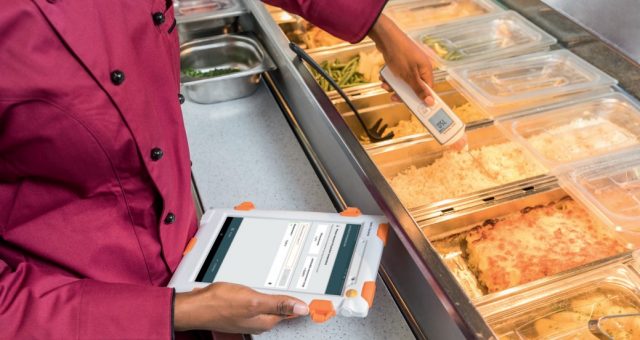Testo Saveris 2 in Food Stores
Using the Testo Saveris 2 in Food Stores to monitor conditions
Testo Saveris 2 in food stores is a common site in the food industry. In his often-quoted book, Out of the Crisis, about quality improvement as a competitive advantage, Edward Deming details 14 principles of quality management. While they are all necessary for a complete quality management mindset, #3 is acutely relevant to changes happening with food quality and food safety today. The third principle states: “Cease dependency on inspections”. This speaks to the heart of what forward-thinking firms around the globe are engaging in eHACCP, digital quality control, and automated food safety. Food service organizations, restaurants, food retailers, convenience stores and everyone in-between currently relies on a multitude of layers to INSPECT QUALITY into their organizations.
Examples of this include corporate quality directors writing and distributing quarterly updated paper checklists, regional managers visually inspecting sites for up-to-date checklists every day, and on-site managers reviewing and physically signing employee check sheets at the end of shifts. In most instances, all of these inspections do little to provide visibility or assurance that policies and procedures are being properly executed daily. So, companies hire third-party inspection services to assess compliance and review documents regularly (monthly or quarterly) to further inspect the quality. Some forward-thinking firms are asking themselves: “Is there a better way? Can we lower the number of inspections, lower costs and improve quality and food safety?”

One regional food retail operation sought to improve quality, lower costs, and reduce inspection efforts by digitizing and electronically distributing their food
quality inspection manuals. This multi-unit company is centrally controlled through the HQ offices. New food safety books are written, reviewed, approved, printed, and distributed from the corporate office. The cost to print and distribute these manuals annually exceeds $40,000. Additionally, hundreds of undocumented management hours are spent ensuring the updated lists are in use across all of the units. This management by inspection is estimated to cost approximately $25,000 annually. It has also been recorded by the third-party inspection firm that most facilities have incomplete inspection reports and pencil-whipped documents across the board. Should an incident occur, the cost to the brand is estimated at no less than one million dollars per potential incident. However, because management understands that all risk cannot be eliminated through the introduction of one system, this brand risk was pushed down to $200,0000 total for purposes of a return-on-investment (ROI) analysis. The amount of 20% of the at-risk dollars was determined to be a reasonable expectation given the scope of the testo Saveris Food Stores system capabilities.
The Project Objective
To implement hardware and software that would eliminate paper, be centrally controlled by the organization, locally adaptable for varying equipment types/menus, eliminate checklists that are not relevant to the site, and be 100% up-to-date every day, everywhere without effort. The system must also be user-driven so that the corporation can easily change and update checklists as needed. Additionally, checklists must have the option to be “seasonal in nature,” meaning they can have timed start and end dates.
During the project scope phase, six (6) different workstations were identified. These were the bakery, deli, soup/salad/wing bar, specialty meat/seafood counter, dairy area, and meat grinding station. For the purpose of a proof of concept during the pilot phase, 2 work stations were chosen in 2 different store locations: the deli & the soup/salad/wing bar. The company’s existing checklists for both work stations were programmed into the testo Saveris Food Stores software system and stationary wireless temperature data loggers were installed in strategic locations to continuously collect data. Two shifts of line staff were trained and provided with Bluetooth-enabled multifunctional thermometers and a rugged purpose-built tablet.

The client wanted to test the flexibility of the system and gauge how their employees reacted to change. It was decided that, over the course of a 90-day trial, checklists were changed at the corporate level. In the control store, communication about these changes followed the normal path. Employees were informed via standard corporate emails and postings on employee bulletin boards about the change. At the test store, employees were not informed of the changes to checklists. The difference in communication at the store level was decided to test how well employees adapt to changes in expectations communicated electronically through the testo Saveris Food Stores system as opposed to the traditional method of informing and inspecting quality in the process.
Findings from the 90-day pilot confirmed the key drivers for the project. Printed checklist costs could be eliminated, which did not surprise the management team. Additionally, the changes to the checklist were automatically followed at both locations regardless of management’s engagement with the line employees. The surprises in the pilot study came from unexpected areas of importance to the organization.
Improvements
In one location, significant improvements were made in the soup/salad/wing bar area. After only 2-weeks of engagement with the system, it was clear that temperatures for foods going into the salad bar at one location were consistently being found outside of minimum expectations. Quality assurance, location management, and Testo started to investigate the situation. The store manager was certain that the new Testo equipment was either gathering data incorrectly or malfunctioning due to improper installment. All hands were called into the location to address the problem and do a field validation of the temperature probe. Testo team then verified that all the equipment was functioning correctly and the quality assurance manager conducted a thorough process analysis of the preparation and production process. During this review, it was identified that the salad bar re-chilling process was not being followed correctly. Salad bar items were not being properly re-chilled to below 40°F prior to being taken out of temperature control and placed on the salad bar. This was allowing several Temperature Control for Safety (TCS ) items to rise slightly (to 43°F) during the salad bar set-up. Training ensued, the handling process was adjusted, and temperatures normalized at the salad bar.
Anecdotally, the manager for both locations found that the overall cleanliness at the Deli counter seemed to improve. During an interview at the end of the pilot study the deli managers were asked, why did they think the managers noticed an improvement in the overall cleanliness and appearance of the deli counter area? The response was clear. Numerous temperature checks were eliminated due to embedded sensors in the deli case and employees had more time to straighten shelves and keep the product appearance at its peak. When asked further to quantify the amount of time saved due to automated temperature checks and automated alarms, employees felt that 30-60 minutes per shift was saved by avoiding numerous hand-recorded temperature checks.
In a round-table discussion with the users at the end of the trial period, an employee pointed out that she thought the system would have created an incredible benefit 6-months prior. At that time, the door was left open in a small walk-in refrigerator behind the deli counter. It went unnoticed and the temperature inside the refrigerator rose above expectations. The deli staff (3 people) spent an hour checking product temperatures by hand. She estimated about $2,000 of meats were lost due to this issue. With open door and temperature alarms sent via email, the system would have found the problem and alerted staff before any food loss.

ROI Evaluation
Each retail location has 6 departments. The department heads review and sign the daily checklist for their department. This is done for 2 shifts per day. The cost for this operation alone can be completely eliminated through the use of the comprehensive, electronic checklists visually available at the store, regional, and corporate levels. Based on 89 locations, the savings to eliminate this effort alone pay for the entire system and are calculated to be $584,000.
- 5 minutes to check each list
- 6 lists to check
- 2 shifts per store
- 60 minutes of labor or 1 hour = 365 Hr/store/Year
- 89 stores x 365 = 32,485Hr/Year Total Saved
- Average Manager pay = $18/Hr
- Total savings = $584,730
All printing is eliminated, creating an additional $40,000 in annual savings. The company also estimated that its managerial inspections for up-to-date documents could be eliminated, saving another $25,000.

